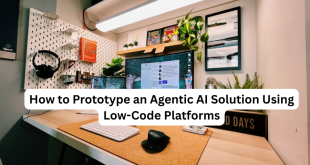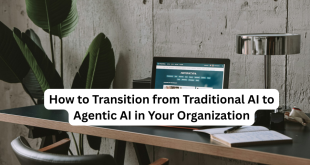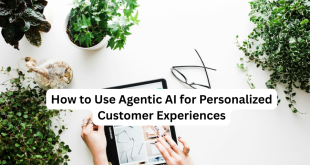Agentic AI—systems that autonomously make decisions and perform tasks—is transforming how businesses operate. For small businesses, this technology offers a way to automate processes, cut costs, and compete with larger players without needing a big budget or a team of experts. In this post, we’ll guide you through building a scalable agentic AI system tailored for small businesses, using affordable tools and a step-by-step approach.
Why Agentic AI Matters for Small Businesses
Unlike traditional AI, agentic AI acts independently to achieve goals, such as responding to customer inquiries or optimizing inventory. Gartner predicts that by 2028, 15% of daily work decisions will be handled autonomously by AI agents. For small businesses, this means more efficiency and time to focus on growth. A scalable system ensures your AI can grow with your business, handling increased demand without costly overhauls.
Let’s dive into the steps to build one.
Step 1: Identify Your Business Needs
Start by pinpointing a specific problem agentic AI can solve. Common use cases for small businesses include:
- Customer Service: AI chatbots that answer queries 24/7, reducing response times.
- Inventory Management: Agents that track stock levels and reorder supplies automatically.
- Marketing Automation: AI that personalizes campaigns or optimizes ad budgets.
Action Item: Choose one task to automate. For example, “Automate responses to 80% of customer FAQs.” This keeps your project focused and achievable.
Step 2: Select Cost-Effective Tools
Small businesses need tools that are affordable, user-friendly, and scalable. Here are some top options for building agentic AI:
- Cloud-Based AI Platforms:
- Google Cloud AI: Offers APIs for tasks like natural language processing or predictive analytics, with flexible pricing for small budgets.
- AWS SageMaker: Provides pre-built models and serverless options, ideal for businesses with some technical expertise.
- Low-Code/No-Code Platforms:
- Microsoft Power Apps: Enables non-coders to build AI-driven apps using drag-and-drop tools, integrating with Microsoft 365.
- OutSystems: A low-code platform for creating custom AI workflows, perfect for rapid deployment.
- Open-Source Tools:
- Hugging Face: Free, pre-trained models for tasks like text generation, customizable for agentic AI.
- Rasa: An open-source framework for building conversational agents, great for advanced chatbots.
Action Item: Pick a platform based on your team’s skills. Non-technical users should try Microsoft Power Apps for its simplicity. If you have a developer, consider Rasa or Hugging Face. Test free trials to find the best fit.
Step 3: Build a Minimum Viable Product (MVP)
Start small by creating an MVP—a basic version of your AI that tackles one core task. For example, a chatbot for customer FAQs or an agent that alerts you to low inventory.
Steps to Build Your MVP:
- Gather Data: Collect relevant data, such as past customer queries or sales records. Ensure it’s clean and organized.
- Choose a Model: Use pre-trained models from your platform (e.g., Dialogflow for chatbots or AWS SageMaker for forecasting).
- Train and Test: Feed your data into the model and test its performance. For a chatbot, verify it handles common questions accurately.
- Deploy: Integrate the AI into your operations, like embedding a chatbot on your website or linking an inventory agent to your e-commerce system.
Pro Tip: Keep the MVP simple to avoid overwhelm. A chatbot covering 5–10 FAQs is a great start. Plan for 2–3 weeks to build and test, depending on your data and platform.
Step 4: Design for Scalability
A scalable system grows with your business, handling more users, data, or tasks. Build scalability into your system from the start:
- Leverage Cloud Infrastructure: Platforms like AWS or Google Cloud scale automatically, managing spikes in demand without manual upgrades.
- Use Modular Architecture: Design your AI in independent modules (e.g., separate chat and analytics functions) so you can add features later, like voice support or advanced reporting.
- Enable Auto-Updates: Choose tools that retrain models with new data, keeping your AI relevant without constant rework.
- Control Costs: Monitor usage on cloud platforms to stay within budget. Set cost alerts to avoid surprises.
Action Item: Confirm your platform supports scaling. Check if it can handle 10x the current data volume or additional features without a full rebuild.
Step 5: Monitor and Refine
After launching your MVP, track its performance and make improvements to ensure it meets your goals.
- Define Metrics: Measure success with KPIs like response accuracy (for chatbots), cost savings (for inventory agents), or customer satisfaction.
- Gather Feedback: Ask customers or staff how the AI performs. For example, are chatbot answers helpful and accurate?
- Iterate: Use new data and feedback to retrain your AI. Most platforms simplify this process with built-in retraining tools.
Example: A small e-commerce store deployed a Google Dialogflow chatbot. After a month, 25% of queries were unresolved. They added more training phrases, improving resolution to 90% in two weeks.
Action Item: Schedule monthly reviews to analyze performance using your platform’s analytics tools. Prioritize updates based on user feedback.
Step 6: Prioritize Ethics and Security
Since agentic AI makes autonomous decisions, ethical and security practices are non-negotiable. Protect your business and customers with these steps:
- Be Transparent: Clearly state when users interact with AI (e.g., “This is our AI assistant”).
- Mitigate Bias: Regularly check your AI’s outputs for fairness. For instance, ensure a marketing AI doesn’t exclude certain customer groups.
- Secure Data: Use platforms with encryption and compliance with regulations like GDPR. AWS and Google Cloud offer robust security features.
Action Item: Set up a quarterly audit to review AI outputs for bias and confirm your platform’s security settings, like data encryption, are active.
Step 7: Prepare for Expansion
As your business grows, your AI should evolve. Plan for the future by:
- Adding Capabilities: Expand your AI’s scope, like adding predictive analytics to a chatbot or multi-language support.
- Integrating Tools: Connect your AI to systems like Shopify, HubSpot, or QuickBooks for seamless workflows.
- Training Staff: Use free resources like AWS Training or Google’s AI courses to upskill your team on managing AI.
Example: A local retailer started with a Power Apps chatbot for inquiries. After a year, they integrated it with Shopify to process orders, boosting sales by 40%.
Action Item: Create a 6–12-month plan for new features or integrations, aligned with your business growth.
Start Building Today
Agentic AI is a game-changer for small businesses, and building a scalable system is easier than you think. By starting small, using affordable tools, and planning for growth, you can automate tasks and scale efficiently. Here’s a quick recap:
- Identify a specific business need.
- Choose tools like Microsoft Power Apps or Rasa.
- Build and deploy a simple MVP.
- Design for scalability with cloud and modular systems.
- Monitor and improve performance.
- Ensure ethical and secure practices.
- Plan for future growth.
Ready to get started? Sign up for a free trial of Google Cloud AI or Microsoft Power Apps and build a basic chatbot or inventory agent. With agentic AI, your small business can work smarter and grow faster.
 UBUCH ubuch | Honest Tech Reviews & Tutorials for Everyone
UBUCH ubuch | Honest Tech Reviews & Tutorials for Everyone




